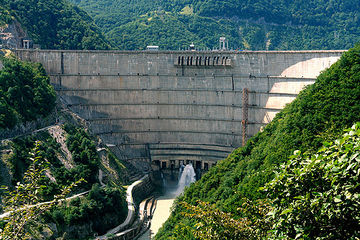Hydropower

Hydropower is the process of utilizing the mechanical potential energy of flowing water, transforming it into electrical energy to generate electricity. Note that in general, this does not refer to the energy obtained by flowing water in the form of tides. In the case of obtaining energy from the tides, the term tidal power is used. The amount of potential energy some stored body of water holds is measured using the height difference between the head race and tail race, known as the hydraulic head. Today, 16% of the electricity in the world comes from hydropower facilities, while values in the earlier twentieth century were much higher. In some countries around the world, hydroelectricity is the main type of electricity that is used.
Countries such as China, Canada, and Brazil are the leaders in total hydroelectricity generation with capacities of 200 GW, 89 GW, and 70 GW respectively.[2] Other notible producers include Russia, India, Norway, Japan, and Venezuela (which is almost completely dependent on hydropower).[2] See the data visualization below for more statistics on hydroelectricity in the world.
Generation
With special technologies, the energy of water can be harnessed by humans and used for electricity generation. Humans have been harnessing energy from water for millennia, although it was not used to generate electricity. The ancient Greeks used water wheels to grind wheat over 2000 years ago.[3] Hydropower continued to be exclusively converted directly into mechanical power up until the end of the 19th century when electrical dynamos where attached to the shaft to generate electricity.[4]
Hydroelectricity is generated at a hydroelectric facility - generally for large-scale generation this includes a hydroelectric dam. At these facilities, a dam holds back a large quantity of water, creating a reservoir. This reservoir holds water at a higher elevation than the rest of the original body of water (generally a river). This means that compared to the water in the river, the water in the reservoir has more potential energy. When a gate is opened at the top of the dam, the water flows through channels called penstocks down to the turbines. When the water reaches the turbines, the potential energy it held from being stored up in a reservoir is transferred to the rotational motion of the turbines. As the turbines spin, they move a generator and generate electricity. This is how hydropower (the power of water) creates hydroelectricity.
Although hydroelectric facilities that have large outputs generally use dams, there are some types of systems that do not utilize dams and have very little water storage (meaning there is no large reservoir of stored water). These types of systems are known as run-of-the-river systems, and are gaining popularity recently as alternatives to large scale reservoir dams.
Classifications
Conventional hydroelectric generation relies on a head difference created by man-made dams and obstructions. The majority of current generation is conventional. Two types of systems that are considered conventional are hydroelectric dams and tidal dams. Unconventional generation techniques generally rely on flow rate or on a small head differential. These platforms produce less energy than conventional methods however they also have less impact on the surrounding environment. Some examples of unconventional hydropower platforms are low head hydro, run-of-the-river systems, instream hydro, and kinetic tidal.
Each type of hydroelectric generation method has an associated output classification based on its capacity. They are outlined in the table below.[5]
| Classification | Capacity |
|---|---|
| Large | > 100 MW |
| Medium | 15 - 100 MW |
| Small | 1 - 15 MW |
| Mini | 100 kW - 1 MW |
| Micro | 5 - 100 kW |
| Pico | ~ 200 W - 5 kW |
Benefits and Drawbacks
The chief benefit of hydroelectricity is that it is less polluting than using the combustion of fossil fuels for electricity. Although not free from emissions and other environmental impacts, they are almost always significantly less polluting than other options. As well, hydroelectricity is relatively inexpensive to operate once dams and reservoirs are built and these facilities can operate at very high efficiencies.[2] For more information on the ecological impacts of hydropower facilities, see: water quality degradation and environmental impacts of hydropower. As well, since hydroelectricity is generated using the mechanical energy of water, which is high-quality energy. Since it is such a high-quality energy it can be converted to electrical energy with near 100% efficiency since there is minimal thermal energy involved (and thus thermodynamics doesn't have to be taken into account). However, there are still minor losses associated with friction and inefficiencies in the transportation of electricity (as a result of factors such as resistance in wires). Overall, this means energy from water can be converted to electricity with efficiencies higher than 90%.[6]
World Electricity Generation: Hydroelectricity
The map below shows the primary energy sources different countries use to generate their electricity. Hydroelectricity is seen in blue. Click on the region to zoom into a group of countries, then click on the country to see where its electricity comes from. Some notable countries include China, Canada, Brazil, Russia, India, Norway, and Venezuela.
References
- ↑ Wikimedia Commons. (August 31, 2015). Ingur Hydroelectric Facility [Online]. Available: https://commons.wikimedia.org/wiki/File:Ingur_Hydroelectric_Power_Station.jpg
- ↑ 2.0 2.1 2.2 Abhishek Shah. (September 2, 2015). List of World’s Largest Hydroelectricity Plants and Countries – China Leading in building Hydroelectric Stations [Online]. Available: http://www.greenworldinvestor.com/2011/03/29/list-of-worlds-largest-hydroelectricity-plants-and-countries-china-leading-in-building-hydroelectric-stations/
- ↑ IEA. (September 2, 2015). What is hydropower’s history? [Online]. Available: http://www.ieahydro.org/What_is_hydropower’s_history.html
- ↑ Water Power Program: History of Hydropower. (n.d.). Retrieved from http://www1.eere.energy.gov/water/hydro_history.html
- ↑ IPCC. (September 2, 2015). Chapter 5 - Hydropower [Online]. Available: www.ipcc.ch/pdf/special-reports/srren/drafts/SRREN-FOD-Ch05.pdf
- ↑ R. Wolfson. Energy, Environment and Climate, 2nd ed. New York, U.S.A.: Norton, 2012

